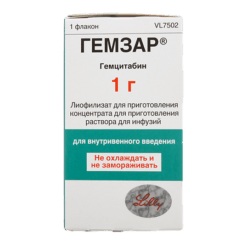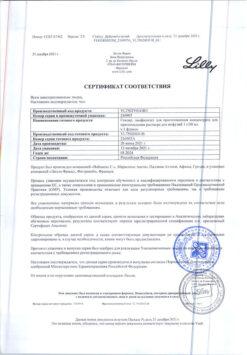No products in the cart.
Description Pharmacotherapeutic group: Antitumor agent, antimetabolite Pharmacodynamics: Pharmacokinetics:
ATC: L.01.B.C.05 Gemcitabine
Gemcitabine is an antimetabolite of the pyrimidine analog group. The drug inhibits DNA synthesis. Exhibits cyclospecificity, acting on cells in S and G1/S phases. It is metabolized in the cell under the action of nucleosidkines with the formation of active diphosphate and triphosphate nucleosides. Diphosphate nucleosides inhibit ribonucleotide reductase, which is the only enzyme that catalyzes the formation of deoxynucleoside triphosphates required for DNA synthesis. Triphosphate nucleosides are capable of being incorporated into the DNA chain (to a lesser extent RNA), which leads to the cessation of further DNA synthesis and programmed cell lysis (apoptosis).
Hemcitabine is also a strong radiosensitizing agent, even at concentrations lower than cytotoxic.
It is metabolized in cells of the liver, kidneys, and blood by the enzyme cytidine deaminase in stages to form the inactive metabolite 2′-deoxy-2′,2′-difluoruridine. The volume of distribution depends significantly on the duration of infusion and gender. Binding to plasma proteins is low (less than 10%). Systemic clearance, which varies from about 30 l/h/m2 to 90 l/h/m2, depends on age and sex (women have 25% less clearance than men; with age gemcitabine clearance decreases). The elimination half-life ranges from 42 minutes to 94 minutes. It is excreted mainly by the kidneys as inactive metabolite 2′-deoxy-22′-difluoruridine (89%) and also unchanged (less than 10%); less than 1% – with feces.
In reduced renal function an inactive metabolite may accumulate in the body.
.
Indications
Indications
– Non-small cell lung cancer
– Pancreatic cancer
– Bladder cancer
– Breast cancer
– Locally advanced or metastatic cervical cancer
Gemcitabine, alone or in combination with other antineoplastic agents, also has activity in ovarian cancer, locally advanced small cell lung cancer, and locally advanced refractory testicular cancer.
Pharmacological effect
Pharmacological effect
Pharmacotherapeutic group: Antitumor agent, antimetabolite
ATC: L.01.B.C.05 Gemcitabine
Pharmacodynamics:
Gemcitabine is an antimetabolite of the pyrimidine analogue group. The drug inhibits DNA synthesis. Shows cycle specificity, acting on cells in the S and G1/S phases. Metabolized in the cell under the action of nucleoside kinases with the formation of active diphosphate and triphosphate nucleosides. Diphosphate nucleosides inhibit ribonucleotide reductase, which is the only enzyme that catalyzes the formation of deoxynucleoside triphosphates necessary for DNA synthesis. Triphosphate nucleosides are able to integrate into the DNA chain (to a lesser extent RNA), which leads to the cessation of further DNA synthesis and programmed cell lysis (apoptosis).
Gemcitabine is also a strong radiosensitizer, even at concentrations lower than cytotoxic.
Pharmacokinetics:
Metabolized in the cells of the liver, kidneys, and blood under the action of the enzyme cytidine deaminase in stages, until the formation of the inactive metabolite 2′-deoxy-2′,2′-difluorouridine. The volume of distribution depends significantly on the duration of infusion and gender. Communication with plasma proteins is low (less than 10%). Systemic clearance, which ranges from approximately 30 l/h/m2 to 90 l/h/m2, depends on age and sex (clearance in women is 25% less than in men; clearance of gemcitabine decreases with age). The half-life ranges from 42 minutes to 94 minutes. It is excreted mainly by the kidneys in the form of an inactive metabolite 2′-deoxy-22′-difluorouridine (89%), as well as unchanged (less than 10%); less than 1% – with feces.
With reduced kidney function, an inactive metabolite may accumulate in the body.
Special instructions
Special instructions
Treatment with Gemcitabine Teva can only be carried out under the supervision of a physician experienced in the use of anticancer chemotherapy.
Before each administration of the drug, it is necessary to monitor the number of platelets, leukocytes and neutrophils in the blood. If there are signs of bone marrow suppression, it is necessary to suspend treatment or adjust the dose. Renal and liver function should be assessed periodically.
Increasing the duration of infusion and the frequency of infusions leads to increased toxicity.
Administration of Gemcitabine Teva for liver metastases, a history of hepatitis and alcoholism, as well as liver cirrhosis increases the risk of developing liver failure.
If the first signs of hemolytic-uremic syndrome occur, treatment with Gemcitabine Teva should be discontinued.
Patients with lung cancer or lung metastases have an increased risk of respiratory side effects.
When the first signs of pneumonitis or infiltrates appear in the lungs, treatment with Gemcitabine Teva should be discontinued.
Gemcitabine Teva can be administered after resolution of acute radiation reactions or not earlier than 7 days after the end of radiation therapy.
Women and men should use reliable methods of contraception during treatment with Gemcitabine Teva and for at least 6 months after.
Impact on the ability to drive vehicles. Wed and fur.:
During the treatment period, care should be taken when driving vehicles and engaging in potentially hazardous activities that require increased concentration and speed of psychomotor reactions.
Active ingredient
Active ingredient
Gemcitabine
Composition
Composition
1 bottle contains:
active substance:
gemcitabine hydrochloride anhydrous 1140 mg in terms of gemcitabine – 1000 mg;
auxiliary components: mannitol, sodium acetate trihydrate, hydrochloric acid and/or sodium hydroxide for pH.
Contraindications
Contraindications
– hypersensitivity to gemcitabine or other components of the drug
-pregnancy and lactation period
With caution:
In case of impaired liver and/or kidney function, suppression of bone marrow hematopoiesis (including against the background of concomitant radiation or chemotherapy), with concurrent radiation therapy, acute infectious diseases of a viral, fungal or bacterial nature (including chicken pox, herpes zoster).
Side Effects
Side Effects
Adverse reactions are classified in accordance with the recommendations of the World Health Organization: very often – at least 10%; often – at least 1%, but less than 10%; infrequently – not less than 0.1%, but less than 1%; rarely – not less than 0.01%, but less than 0.1%; very rarely (including isolated cases) – less than 0.01%.
From the hematopoietic organs: very often – leukopenia, neutropenia, thrombocytopenia, anemia; often – febrile neutropenia; very rarely – thrombocytosis, microangiopathic hemolytic anemia (rapid decrease in hemoglobin with concomitant thrombocytopenia, increased serum concentrations of bilirubin, creatinine, urea nitrogen or increased lactate dehydrogenase (LDH) activity).
From the digestive system: very often – nausea, vomiting, increased activity of liver transaminases, alkaline phosphatase; often – anorexia, diarrhea, constipation, stomatitis, ulceration of the oral mucosa, increased bilirubin concentration; rarely – increased activity of gamma-glutamine transferase; frequency cannot be estimated based on available data – toxic liver damage, including liver failure, ischemic colitis.
From the urinary system: very often – mild hematuria and proteinuria; the frequency cannot be estimated based on the available data – acute renal failure, hemolyticouremic syndrome (microangiopathic hemolytic anemia, thrombocytopenia and acute renal failure).
From the skin and skin appendages: very often – alopecia; rarely – peeling, formation of blisters and ulcers, increased sweating; very rarely – severe skin desquamation, bullous skin rash.
From the respiratory system: very often – shortness of breath; often – cough, rhinitis; uncommon – bronchospasm, interstitial pneumonitis, pulmonary edema; rarely – acute respiratory distress syndrome.
From the cardiovascular system: rarely – decreased blood pressure (BP), myocardial infarction; frequency cannot be estimated based on available data – heart failure, arrhythmia (mainly supraventricular).
From the nervous system: often – headache, drowsiness, insomnia, paresthesia; rarely – cerebrovascular accident, including stroke.
Allergic reactions: very often – skin rash accompanied by itching; very rarely – anaphylactic reactions; frequency cannot be estimated based on available data – Lyell’s syndrome, Stevens-Johnson syndrome.
From the musculoskeletal system: often – back pain, myalgia.
Other: very often – feeling of malaise, flu-like syndrome, peripheral edema (usually disappears after cessation of treatment); often – increased body temperature, chills, asthenia; infrequently – swelling of the face; rarely – reaction at the injection site; very rarely peripheral vasculitis, gangrene.
Interaction
Interaction
Gemcitabine Teva has a radiosensitizing effect, therefore, when using the drug during radiation therapy, an increase in radiation reactions can be expected.
Reduces the production of antibodies and increases side effects with the simultaneous use of inactivated or live viral vaccines (the interval between the use of drugs should be from 3 to 12 months).
Overdose
Overdose
Symptoms: myelosuppression, paresthesia, severe skin rash.
Treatment: there is no specific antidote. If an overdose is suspected, the patient should be under constant medical supervision, including counting the blood count; If necessary, symptomatic treatment is carried out.
Storage conditions
Storage conditions
List B.
Lyophilisate – at a temperature not exceeding 30 °C.
Prepared solution – at a temperature not higher than 25°C.
Keep out of the reach of children!
Shelf life
Shelf life
2 years.
Prepared solution – 6 hours.
Do not use after the expiration date stated on the package.
Manufacturer
Manufacturer
Actavis Italy S.p.A., Italy
Additional information
| Shelf life | 2 years. Prepared solution – 6 hours. Do not use after the expiration date printed on the package. |
|---|---|
| Conditions of storage | List B. Liofilizate – at a temperature not exceeding 30 °С. Prepared solution – at a temperature not exceeding 25 °С. Store out of reach of children! |
| Manufacturer | Actavis Italia S.p.A., Italy |
| Medication form | lyophilizate |
| Brand | Actavis Italia S.p.A. |
Other forms…
Related products
Buy Gemcitabine-Teva, 1000 mg lyophilizate with delivery to USA, UK, Europe and over 120 other countries.














